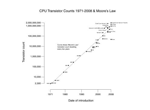Trends in the Semiconductor Industry
1960s
Birth of IC’s in US, and its mass-production in Japan ( Linear IC’s for consumser applications in particular.)
ICs contributed to the success of Japanese consumer electronics (in such products as color TVs, electronic calculators, and electronic quartz watches).
Japan became an advanced country as its economy expanded dramatically: per capita GDP, at $2,000 in 1950, increased to $10,000 in 1970.
1960s to 1970s: Management in Japanese semiconductor companies focuses on quality
While most U.S. manufacturers considered their responsibility for the quality of products to apply only over a limited period, Japanese manufacturers considered this responsibility to be unlimited and brought quality control to the core value of their business.
Early 1960s: Japan becomes the biggest volume manufacturing country of transistors.
After importing silicon-transistor technologies from the U.S., Japan developed its own mass-production technologies and factories, and became the overall biggest transistor-manufacturing country.
1965: Moore's Law announced in Silicon Valley
Gordon Moore (from Fairchild) predicted that the number of components per chip would double each year. This was a rule of thumb that expressed the evolution of IC chips as an exponential progression.
1965 and later: Rising Japanese manufacturers expedite their own development and mass production while importing IC technologies from the U.S.
As the countermeasure to the problems such as shortage of workers and high fixed costs in production operations around Tokyo, Japanese manufacturers started to build factories in other regions, e.g.Toshiba’s Oita operation, Mitsubishi’s Kumamoto operation, and NEC’s Yamagata operation. Major products were analog ICs, bipolar ICs, and, from the late 1960s, CMOS ICs.
1968: Start of the Super High-Performance Computer Development Project with support from the Japanese Government
The scale of the Japanese computer market, initiated by the development of mainframes by NEC, Hitachi, and Fujitsu, significantly grew from 50 to 330 billion yen between 1965 and 1970.
However, since American manufacturers led by IBM still dominated high-end market share, the Japanese government launched the Super High-Performance Computer Development Project with the aim of strengthening the development by domestic manufacturers.
1968: Founding of Intel
Robert Noyce and Gordon E. Moore left Fairchild and founded Intel. At that time, Intel’s key product was memory. It was not until 1971 that Intel, in collaboration with Busicom in Japan, developed the first MPU, the 4-bit MPU 4004.
1969: Sharp releases the QT-8D calculator
Sharp went on to release the EL805 in 1973. The main circuits of this product were on a single CMOS LSI chip. An LSI circuit from Rockwell in the U.S.A. was initially employed but was later replaced by the Japanese products.
1969: Seiko releases the Astron, world’s first electronic wristwatch
Seiko initially used a CMOS IC developed in collaboration with Intersil. However, when Seiko and other Japanese manufacturers developed new single-chip CMOS LSIs, Seiko employed these LSIs. After 7 years, with other companies joining the industry, the production of electronic watches in Japan surpassed Switzerland, the leading watch producer in 1976.
1969: Intel releases the world’s first semiconductor memory, the SRAM3101, leading to the move for semiconductor memory to replace core memory in computers
Intel, which regarded memory as the core of its business at the time, released the world’s first DRAM, the 1103, in 1970, and also the first EPROMs, 1702 and 2716, in 1971.
1969 and later: Nippon Telegraph and Telephone Public Corporation (NTT) promotes the development of LSI circuits for telecommunications equipment
Throughout the 1960s and 1970s, NTT was the top customer to the Japanese semiconductor companies in telecommunication market.
NTT took initiative on a number of IC-development projects involving collaboration among multiple IC manufacturers (for applications ranging from electronic private branch exchanges to telephones), and they set very strict requirements on reliability testing and realizations of high quality achieved through the use of stable manufacturing processes.
This contributed to the further improvements of product and operational quality of Japanese semiconductor companies.





